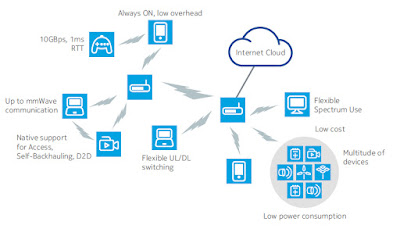Augmented Reality (AR) and Virtual Reality (VR) are two distinct experiences, built on very similar underlying technologies. The performance of both AR and VR depends upon the network. Though the 4G networks provide high data rates, the data rates required by AR and VR are not completely achieved through 4G; latency and capacity are the major problems faced by 4G communication with respect to VR and AR.
Read more: 5G is more than communication for smartphones!
Capacity:
The way we want to experience videos has changed a lot over years. The next generation videos come with high resolutions like 4k and 8k, with 360 degrees coverage and high framerates. Videos meeting all these characteristics result in huge size files. Through 4G communication, such high resolution videos cannot be streamed smoothly; to be particular, VR or AR can provide the intended experience to the user through 4G. Hence, 5G comes into rescue that can provide much higher datarates in comparison with 4G. The peak datarate of 5G communication is expected to be 20Gbps where as the datarates at cell edges to be 100Mbps.
Latency:
Latency is a major factor that affects the experience of users with VR and AR. For the videos like 360-degrees, latency is not an issue. Such videos are "static" in nature. But, this is not the case in VR or AR videos. These videos are almost "dynamic" in nature. Once a user starts streaming a VR video, these should not be a pause for buffering, which kills the user experience with VR. The 5G communication is capable of providing such flawless experience to the users.
Read more: Huawei's TAC-2020 based on Tactile interent.
The 5G latency can be broken down into three network topologies - Public cloud to device, Telco cloud to device and Telco edge to device. The latencies of these toplogies are very less when compared to the 4G communication - 50ms to 100ms, 20ms to 50ms and 1ms to 2ms, respectively.
High mobility:
Mobility of human beings affects on communication. When the user is using smartphones for data streaming, mobility plays a major role in communication. Suppose that a hand-off occurred when a user is playing an online VR game. This results in the disturbance in the game and finally affects the user experience. When compared with 4G, 5G is very less affected by hand-offs. Though the user is moving with speeds higher than normal speeds, this is not going to affect the data streaming of the user.
5G communication is not just about mobile communication as 4G did. It is a mode of communication. Unlike 4G, 5G is going to serve every aspect of communication to provide an always-connected environment to the user. With IoT and AI, 5G plays a major role in connecting devices and humans. The part of 5G communication in smart devices is to the maximum extent. In the automobile industry, with the invent of automotive vehicles integrated with IoT and AI, 5G communication can efficiently serve the purpose, when compared to 4G communication.
Read more: Is 5G really better than 4G?
Read more: 5G is more than communication for smartphones!
Capacity:
The way we want to experience videos has changed a lot over years. The next generation videos come with high resolutions like 4k and 8k, with 360 degrees coverage and high framerates. Videos meeting all these characteristics result in huge size files. Through 4G communication, such high resolution videos cannot be streamed smoothly; to be particular, VR or AR can provide the intended experience to the user through 4G. Hence, 5G comes into rescue that can provide much higher datarates in comparison with 4G. The peak datarate of 5G communication is expected to be 20Gbps where as the datarates at cell edges to be 100Mbps.
 |
| The bandwidth requirements for streaming various visual content |
Latency is a major factor that affects the experience of users with VR and AR. For the videos like 360-degrees, latency is not an issue. Such videos are "static" in nature. But, this is not the case in VR or AR videos. These videos are almost "dynamic" in nature. Once a user starts streaming a VR video, these should not be a pause for buffering, which kills the user experience with VR. The 5G communication is capable of providing such flawless experience to the users.
 |
| Network topology of 5G communication for least possible latency |
The 5G latency can be broken down into three network topologies - Public cloud to device, Telco cloud to device and Telco edge to device. The latencies of these toplogies are very less when compared to the 4G communication - 50ms to 100ms, 20ms to 50ms and 1ms to 2ms, respectively.
 |
| Capacity vs Latency |
Mobility of human beings affects on communication. When the user is using smartphones for data streaming, mobility plays a major role in communication. Suppose that a hand-off occurred when a user is playing an online VR game. This results in the disturbance in the game and finally affects the user experience. When compared with 4G, 5G is very less affected by hand-offs. Though the user is moving with speeds higher than normal speeds, this is not going to affect the data streaming of the user.
 |
| Mobility in 5G |
Read more: Is 5G really better than 4G?











People using AR and VR might be accessing information on train times while on the move, holding conference calls with colleagues or playing computer games with friends in different locations around the world, all in real time. I like this post, the information are quite interesting.
ReplyDeleteVR Development
Very well written. You got every point explained. Loved the whole article! Many thanks!
ReplyDelete4D Virtual Reality